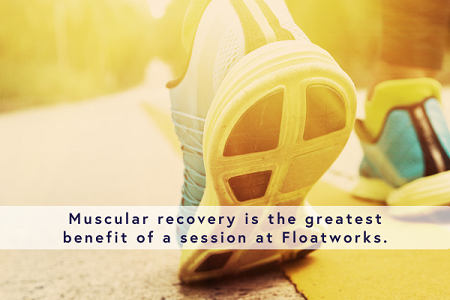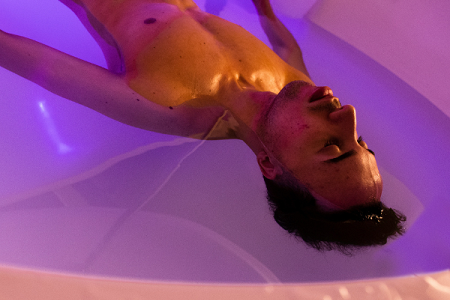An introduction to Journey Works floating
We catch up with regular floater, Tim Woodburn, to find out how floating and Journey Works can help on your quest for self-improvement…

Such is the nature of floating and its ability to help you explore your deeper consciousness, we have many regular faces at Floatworks who come to use the tank as a tool for that very purpose. As well, we find many customers discover floating at a turning point in their lives, when they’re looking to address fundamental parts of their personality through meditation, floating, spirituality, or something else. Draw a tidy Venn Diagram of those two groups and Tim Woodburn sits comfortably in the middle.
A decade ago, Tim was living and working in London as a full-time musician, writing and performing what he dubs “retro pop”. Marriage beckoned and as a young couple looking to live a more holistic life, they upped sticks to run his in-laws’ family farm on a tiny outcrop called King Island, just off the coast of Tasmania. That’s quite the change by anybody’s standards. Several years later, he’s back on home soil without his wife by his side, and training to be a Journey Works practitioner.
Altogether now: “Journey… what?”
“Journey Work is a guided process in which the main aim is to get the person back to who they were born to be,” Tim begins to explain over the phone one Tuesday lunchtime. “The theory is, that through our lives we experience bumps in the road and they knock us off course. That culminates in our eventual personality – however, these bumps in the road can be ironed out if we so desire.
Initially conceived by US native Brandon Bays and documented in her 1999 book The Journey, Journey Works in its most superficial sense, is a methodology of self-improvement. Behind the mythology, it’s a very real – and extremely popular – holistic meditation-based therapy being practiced from London to Adelaide.
The theory is this, and it’s one shared by many other schools of psychology and philosophy: the ego dominates the conscious mind, and because our conscious mind tends to be noisy and overpowering, it naturally causes us to pay less attention to our deeper and more insightful subconscious mind. But through meditation, yoga, floating and other means, we can dull the conscious mind and allow the subconscious to overcome, and examine ourselves free from our own judgement. With the guidance of a Journey Works practitioner, Tim and many others are capable of journeying back through their subconscious memories, and address life-changing events that have shaped who they are today. And it’s all based around forgiveness.
“If you want to forgive someone,” Tim continues, “you have to go back and forgive the people or person or experience that created the disturbance in who you are. We can all blame our parents for screwing us up, but it’s essential that we realise they or anyone else can only do what they can do. We’re all the sum of our own experiences, and we can’t blame people for something they haven’t done.
“We journey back through meditation. There are two journey processes you can use – one emotional, one physical. Essentially, both take you back to those bumps in the road when they happened, and where they happened. We play those scenarios and situations on a screen in front of us. And we’re able to identify who’s present, or what happened. And once we identify exactly where we feel that things changed in our lives, we can then use our younger voice to say how we felt. So often, voices and emotions are suppressed when we’re young. And that’s cathartic in so many ways.”
For Tim, it’s reaching that deep meditative state that attracted him to floating. We’ve spoken about how setting intentions before a float can have real benefits to your experience, and Tim explains how it’s similar to setting intentions before engaging in his Journey Works meditation.
“Before going to bed, and before getting into that state, I find if I put out an intention, I can dream that night and I can begin to understand where I go next on my journey. And I can do the same with floating. By shutting down our sensory perceptions in a float tank, we can dull the ego. And we can lose that false sense of identity and allow our true feelings to arise.”
“Journey Works is essentially the path we take through the subconscious. It’s understanding the difference between our brains and our hearts. Our heart has a memory system that develops as it develops. And arguably, I believe, stores our true wisdom. Or, we can call them feelings. Our brain, I believe is a processor, that stores thoughts. Thoughts and feelings are very easily confused. They’re two entirely different things. Journey Works is about feelings – not thoughts. In order to do that, through meditation and various extra therapies – yoga, floating, and so on – we can settle our mind so that is oscillates at a certain rhythm and we produce theta waves.”
“If we’re to split our brain into three parts, when our brain is oscillating at that frequency, it has an effect where we begin to shut down our fight or flight system, which is what we know as the Reptilian brain. The neocortex – the two big hemispheres on top there that effectively control our conscious memories, our thoughts – then gets into a state where our subconscious memory is able to rise.”
If this sounds familiar, it’s because it should. Floating, like Tim’s Journey Works meditations, can shift your brain’s activity from beta to lower frequency alpha and theta waves, allowing the two hemispheres of your brain to work in a more balanced way where the creative, problem solving and subjective subconscious is allowed equal attention to the practical, perpetually stimulated conscious.
And for any kind of meditation – Journey Works or otherwise – floating can be the perfect shortcut.
To find out more about Journey Works and Brandon Bays’ book The Journey, head to www.thejourney.com










